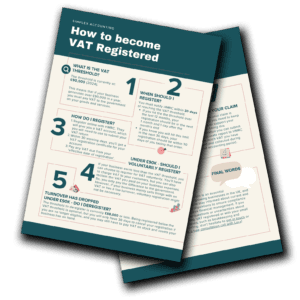VAT — it’s one of those things you know you should understand, but it’s easy to put off. And if you’re a small business owner trying to juggle a hundred things already, the last thing you need is another confusing bit of tax admin.
The good news? VAT doesn’t have to be a nightmare. In fact, once you know the basics, it’s pretty straightforward. This guide is here to explain VAT in plain English, so you can feel more confident about where you stand, what to do next, and when to ask for a bit of help.
What is VAT?
VAT stands for Value Added Tax. It’s a tax you add to most goods or services you sell, and pass on to HMRC. If you’re VAT-registered, you’ll also be able to claim back VAT on eligible business expenses. Think of it like a pass-through tax—you collect it on behalf of the government, not for yourself.
If you’re not VAT-registered, it doesn’t affect you (yet). But once your business grows, you might hit the threshold and need to register. That’s why it’s good to get your head around it early.
When Do You Need to Register?
VAT registration kicks in once your taxable turnover hits £90,000 in any rolling 12-month period. That’s not based on the tax year or calendar year—it’s any stretch of 12 months, so it’s something to keep an eye on as your business grows.
Here’s when it becomes a must:
- You’ve already passed the £90k mark in the last 12 months.
- You’re about to cross that line in the next 30 days.
You’ve also got the option to register voluntarily, even if you’re not quite there yet. It can be a smart move if:
- Most of your clients are VAT-registered and can reclaim what you charge.
- You’re spending a lot upfront and want to reclaim VAT on purchases.
- The aim is to appear more established to bigger clients.
There’s no one-size-fits-all answer. Sometimes it makes sense to wait. Other times, registering early is a smart financial move. A quick chat with an accountant can help you weigh up the options without second-guessing yourself.

FREE VAT REGISTRATION GUIDE
Confused about VAT registration? Our free, easy-to-follow guide explains who needs to register, when, and why it could benefit your business. No jargon—just clear, practical tips. Pop in your details and we’ll send it straight to your inbox. Simple, helpful, and totally free!
How Does VAT Work?
Once you’re VAT-registered, here’s what the general process looks like:
- First, you’ll add VAT to your invoices (this is called output VAT).
- Then, you’ll pay VAT on your business expenses (input VAT).
- Every quarter, you’ll need to file a VAT return showing the VAT you’ve charged and paid.
- Based on that return, you’ll either pay the difference to HMRC—or get a refund if you’ve paid more VAT than you collected.
Let’s say you billed £2,000 in VAT and spent £1,200 on VAT-inclusive expenses. You’d owe HMRC £800. Nice and simple.
Which VAT Rate Should You Use?
There are three main VAT rates in the UK:
- 20% (standard rate) – most goods and services
- 5% (reduced rate) – things like home energy and children’s car seats
- 0% (zero rate) – most food, books, children’s clothing
Some items are also VAT exempt—like insurance or education. These are treated slightly differently, so if you’re unsure, it’s worth double-checking to avoid mischarging.
What Happens After You Register?
Once you’re VAT-registered, you’ll need to:
- Add VAT to your invoices
- Submit VAT returns to HMRC (usually quarterly)
- Keep digital records using Making Tax Digital-approved software like Xero
- Stay on top of deadlines to avoid fines
It can feel like a big jump, but with the right systems (and maybe a bit of support), it quickly becomes part of your normal business routine.
Can You Claim Back VAT?
Yes! One of the biggest perks of being VAT-registered is being able to reclaim VAT on business expenses. This includes things like:
- Tools and equipment
- Office supplies
- Software and subscriptions
- Business travel (where VAT applies)
That said, not everything counts. You can’t claim VAT on personal use or on most client gifts, for example. Good record-keeping is key—and using accounting software like Xero makes this much easier.
What If You Make a Mistake?
VAT mistakes happen. You might use the wrong rate, forget to register on time, or misfile a return. It’s not the end of the world, especially if you catch it early.
If you do make a mistake:
- Small errors can usually be corrected in your next return.
- Bigger ones might need a call to HMRC.
Either way, it’s much less stressful if you’ve got someone in your corner who knows how to handle it.
Quick Tips for Managing VAT Without the Stress
- Use cloud accounting software (like Xero) to track income, expenses, and VAT as you go.
- Set calendar reminders for your VAT return deadlines.
- Check your turnover regularly if you’re not yet registered.
- Keep digital receipts so you don’t miss out on reclaimable expenses.
And if in doubt—ask an expert.
Final Thoughts
Understanding VAT is part of running a growing business—but that doesn’t mean you have to figure it all out on your own. Whether you’re approaching the threshold or already registered, having an accountant on hand means you’ll stay compliant, avoid costly mistakes, and free up more time to focus on the parts of the business you actually enjoy.
If you’d like some help getting set up for VAT, managing returns, or deciding whether to register, I’d be happy to help.
Need a hand with VAT?
Let’s chat. Whether you’re just getting started or feeling a bit stuck, I can help you make VAT simpler and stress-free.


Comments are closed